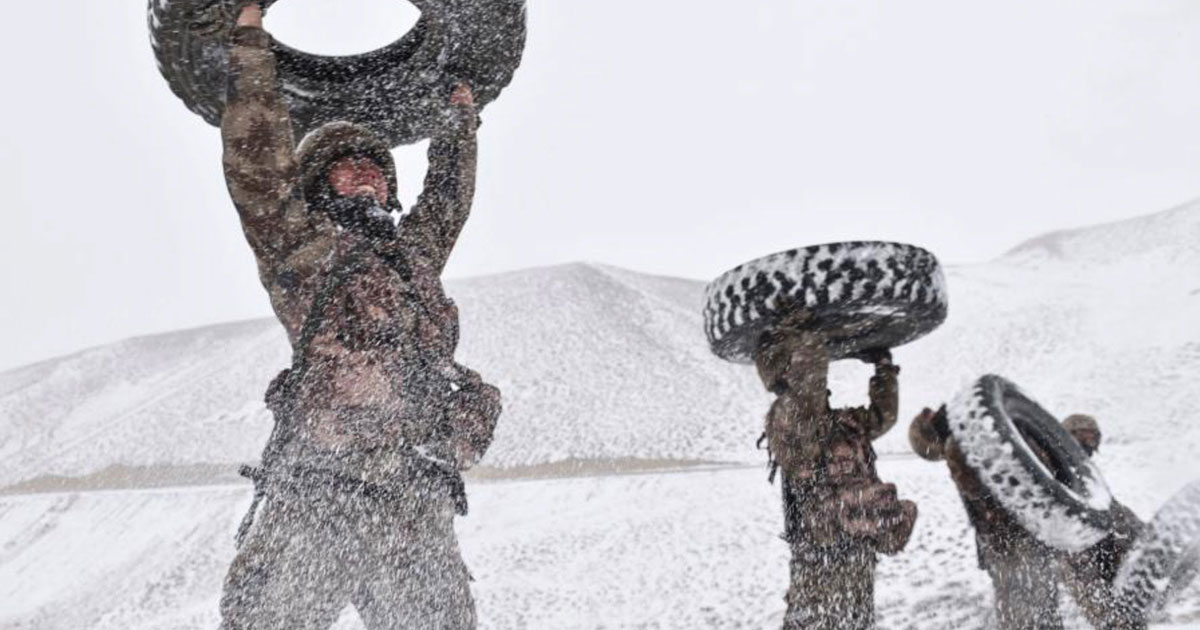
Chinese state media images of PLA soldiers training at high altitude in Ngari.
On the same day as a major prayer festival in Tibet on March 2 (2018), the Chinese authorities held a major military drill in Lhasa termed as a ‘wall of steel’ in the buildup to the sensitive political anniversary of Tibetan Uprising Day, March 10, in 1959. This week is also the tenth anniversary of a wave of overwhelmingly peaceful protests that swept across Tibet from March 10, 2008.
The joint military drill on March 2 (2018) consisted of a mass show of force of ‘combat-ready’ troops from the People’s Liberation Army (PLA) and the People’s Armed Police (PAP), underlining the heavy militarization of Tibet and the political importance at the highest-levels in China of Tibet’s ‘stability’. In its extreme nature, this massive show of force – which has become an almost annual ritual at this time of year – is also an indicator of CCP anxieties over its authority in Tibet.
The military drills coincided with the mass presence of troops at prayer festivals in monasteries in eastern Tibet, giving the impression of a war zone. Despite the heavy show of force, thousands of Tibetan pilgrims still came to monasteries and religious sites to offer prayers.[1]
The Chinese state media reported that the drills were held in order to demonstrate the resolve of the authorities to ensure ‘social stability’, political language for the crushing of any dissent and ensuring allegiance to the CCP authorities in order for the authorities to pursue their strategic and economic objectives on the plateau without impediment. Intensive militarisation is backed by systematic grass roots propaganda work by thousands of Party cadres working in towns and remote rural areas across the plateau, and comprehensive surveillance.
(Click image to launch slideshow)
These clips from Chinese state media television show military drills in Lhasa on March 2, 2018.
Chinese Party officials connect political ‘stability’ in Tibet with the security of the entire PRC, and Xi Jinping has emphasized that: “To rule the country, it is imperative to rule the frontiers; to rule the frontiers, stabilizing Tibet must be done first”.[2]
Last month, China released images of fighter jets flying over the Tibetan plateau conducting aerial combat training exercises and announced its upgrading of Tibet’s military capabilities “in order to confront any threat from India”, according to a Chinese military specialist. “The Western Theater Command of the PLA is mainly responsible for mountain warfare at the border area with India,” an article in The Global Times stated. The state media publication cited Song Zhongping, a Chinese military expert and TV commentator, as saying that it is “significant for China to strengthen control of airspace over the mountainous region.”[3]
The state media has emphasized both border security in Tibet and the importance of ‘social stability’ since the beginning of the year; last month it posted images of PLA soldiers carrying out intensive training at -15 temperatures in the border area of Ngari (Chinese: Ali) in the Tibet Autonomous Region.[4]
China’s rubber stamp Parliament, the National People’s Congress, is meeting in Beijing from today (March 5), and has announced a military budget of 1.11 trillion yuan ($175bn) for the coming year, an 8% increase on last year.[5]
Footnotes:
[1] Images at International Campaign for Tibet report, ‘Images of repression and resilience from Tibet on Day of Miracles’, March 3, 2018, https://www.https://savetibet.org/images-of-repression-and-resilience-from-tibet-on-day-of-miracles/
[2] This is known as a ‘strategic thought’ of Xi Jinping.
[3] Global Times, February 20, 2018, ‘China upgrades airspace defense in west to counter threat from India’, http://eng.chinamil.com.cn/view/2018-02/20/content_7947571.htm. Last year, during serious border tensions over the Doklam area between China and India, China released footage of a major military live-fire assault exercise in the Tibet Autonomous Region. During the exercise in July (2017), soldiers used flame-throwers, rocket-propelled grenades and heavy machine guns to strike bunkers and various types of heavy weapons, including mortars, self-propelled howitzers, multiple rocket launchers and anti-tank missiles in the display of fire-power, which also trialled a new type of tank. See: International Campaign for Tibet report, ‘Major live fire drill testing new tanks in Tibet highlights political imperatives, military capacity on plateau’, July 21, 2017, https://www.https://savetibet.org/ict-inside-tibet-major-live-fire-drill-testing-new-tanks-in-tibet-highlights-political-imperatives-military-capacity-on-plateau/
[4] Xinhua, February 26, 2018, http://en.tibetol.cn/html/Photos/ES/2018/0226/891.html#4
[5] Xinhua, ‘China to increase 2018 defense budget by 8.1 percent’, March 5, 2018, http://english.chinamil.com.cn/view/2018-03/05/content_7959827.htm
















